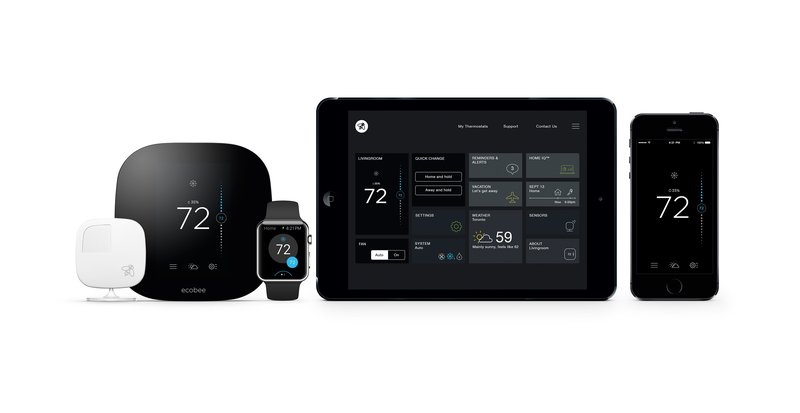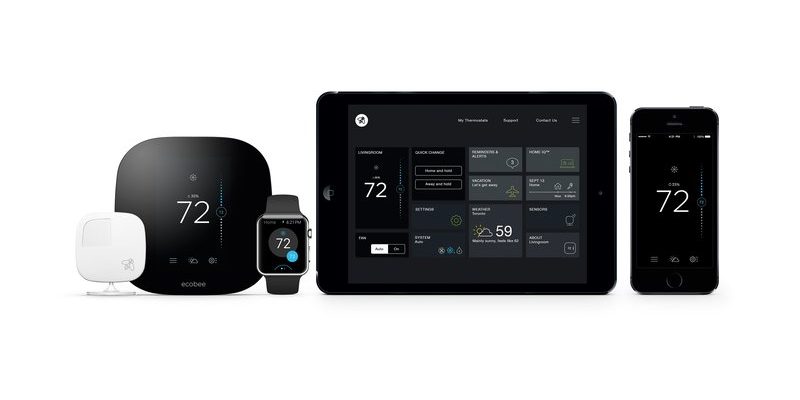
Here’s the thing: Ecobee’s smart remotes (officially called “SmartSensors”) are like little helpers that tell your main thermostat what’s happening in different rooms. Maybe your basement is always chilly, or your upstairs bedroom gets stuffy in the afternoon. Instead of playing a non-stop thermostat tug-of-war, these sensors let you balance comfort all over the house. But adding more than one remote brings up a bunch of questions. Is it easy to pair extra sensors? Does it mess up the system? Can you really trust that your rooms won’t compete for control? Let me break it all down—no jargon, no big assumptions, just straight answers for anyone curious (or slightly overwhelmed) by smart home tech.
How Ecobee Smart Remotes Work With Your Thermostat
The basic pitch behind Ecobee’s system is pretty clever. Instead of relying on a single thermostat to read the temperature (often in your hallway), you can place SmartSensors in rooms you actually use. These sensors track temperature and occupancy—meaning they know if someone’s in the room or not. If you’re binge-watching a show in the den, the sensor tells the main Ecobee thermostat, “Hey, cool it here!” It’s a setup that feels almost like your house is listening to your comfort preferences.
Pairing a remote sensor is pretty painless. There’s no need to run wires or mess with complicated code. Pop in the included battery, launch the Ecobee app, and follow the on-screen instructions to pair it. The process usually involves scanning a QR code on the back of the sensor or entering a pairing code. The app helps you name each sensor (like “Nursery” or “Home Office”), so you’ll know exactly which one’s pinging the thermostat. No IT degree required—just a bit of patience.
Once connected, each remote sensor can send its readings to your thermostat in real time. You can program which rooms you want the system to “pay attention to” at different times of day. For instance, you may set it to focus on bedrooms overnight and the living room during the day. It’s kind of like being the DJ of your home’s climate—choosing which rooms get the spotlight, and when.
Can You Connect Multiple Ecobee Smart Remotes In One Home?
You might be wondering, “How many sensors are too many?” Here’s some good news: Ecobee thermostats are built to support several SmartSensors at once. Depending on the model, you can connect up to 32 sensors to a single thermostat. Realistically, most people probably won’t use more than a handful, but if your house is sprawling or you want every corner covered, it’s doable.
Adding multiple remotes follows the same easy pairing process. Just add each sensor through the app one at a time. Be patient—sometimes the sensors need a moment to wake up, pair, and sync with the thermostat. You shouldn’t run into technical limits unless your home is the size of a small hotel. If things ever get weird—like if a sensor isn’t connecting—try resetting the device or moving it closer to the thermostat for initial setup. Ecobee’s troubleshooting section covers the usual suspects: battery issues, Wi-Fi hiccups, or pairing errors.
Having multiple SmartSensors means your system gets a much fuller picture of your home’s living conditions. Instead of controlling the climate based on a single spot, the thermostat can blend readings from the rooms you care about most. This isn’t just a fancy trick—it makes your heating and cooling way smarter, and that can save money and boost comfort.
How Ecobee Chooses Which Room To Heat or Cool
Okay, so let’s say you’ve got three Ecobee remotes: one in the master bedroom, one in the living room, and one in the baby’s room. Who gets to decide what temperature matters most? Here’s where Ecobee’s logic gets interesting.
The magic comes from a feature called Follow Me. When this mode is turned on, Ecobee keeps track of which sensors are detecting motion—basically, where people actually are. The thermostat will then **average** the temperatures from the rooms where activity is detected, and adjust heating/cooling to target those spaces. For example, if everyone’s watching TV in the living room at 8 PM, the system focuses on comfort there. If someone moves to the bedroom, it follows.
You’re also in charge. Through the app, you can choose which sensors to include in the averaging—great for parents who want the nursery always comfortable, or for anyone with a home office that can’t be ignored. There’s freedom to set specific schedules, like including just the bedrooms at night or turning off the basement sensor during summer.
This sensor logic helps avoid the classic problem of a cold hallway thermostat making the rest of the house overheat. Instead, your comfort is customized in a way that old-school systems can’t match.
Setting Up and Syncing Multiple Ecobee Smart Remotes
Setting up several Ecobee remotes doesn’t require a ton of technical know-how, but there are some steps that’ll make your life smoother. After pairing each sensor (remember, scan the QR code or use the pairing code), the app will ask you to name them. Pick clear, specific names so you can quickly see what’s going on (“Basement Couch” beats “Sensor 3,” trust me).
Next, check the placement of each sensor. Ecobee sensors work best when they’re out in the open, at a reasonable height (waist to chest), and not in direct sunlight or next to vents. If you tuck them behind books or set them near electronics, you might get inaccurate readings. This can throw off the whole comfort formula.
Give your sensors time to sync with the thermostat. Sometimes they need a few minutes to update their readings, especially after a battery change or reset. If one doesn’t show up in the app, double-check the battery, try moving it closer, or walk through the pairing process again. The Ecobee app has a troubleshooting menu if you run into persistent issues—things like a sensor not showing up, or failing to register movement.
Real-World Example: Using Multiple Remotes in a Two-Story Home
Let me paint a picture. Say you’ve got a two-story house, with bedrooms upstairs and a living room plus kitchen downstairs. In the winter, the upstairs sometimes cooks while the downstairs stays chilly. Honestly, this is the kind of scenario where Ecobee’s multiple remotes shine.
You might place one SmartSensor in the living room, another in the hallway upstairs, and maybe a third in your child’s room. During the day, tell Ecobee to pay attention to the living room and kitchen sensors—keeping things cozy where you hang out. At night, switch the system to focus on the bedrooms, ensuring they’re not uncomfortably hot or cold while you sleep.
If you notice a persistent problem—like one bedroom always reading colder than the rest—you can adjust the system to favor or ignore specific sensors. It’s a little like having a home climate DJ taking requests, rather than a strict manager who only listens to one spot.
This flexibility is a game changer for anyone living in a home with tricky temperature zones. Multiple remotes let you adapt in real time, instead of fighting with the thermostat or feeling like you’re playing climate roulette.
Battery Life, Maintenance, and Troubleshooting with Multiple Sensors
Here’s something you’ll appreciate: Ecobee SmartSensors run on standard coin-cell batteries (CR-2477 or similar). With normal use, a battery should last about 18–24 months, depending on how often the sensor detects motion and how far it is from the thermostat.
When you’ve got several sensors, you might worry about tracking battery life. The Ecobee app will send you alerts when a battery runs low. Honestly, it’s still smart to jot down when you installed them, just in case. Changing the battery is as simple as popping off the sensor’s back cover and swapping in a new one.
Troubleshooting with multiple remotes is usually straightforward. If a sensor drops offline or stops reporting, check the battery first. Next, try resetting the sensor (there’s a tiny button inside) and walk through the pairing steps again. If you run into repeated issues—like all your sensors losing sync at once—look into your Wi-Fi connection or try resetting your thermostat. The Ecobee support site is surprisingly user-friendly, and most fixes don’t require special tools or advanced skills.
Comparing Ecobee Sensors to Universal or Third-Party Remotes
It’s tempting to ask: can you just use universal remotes or third-party sensors with your Ecobee? Here’s the short answer: no. Ecobee’s SmartSensors are designed specifically to work (and sync) with Ecobee thermostats. They communicate using a proprietary wireless signal—not your Wi-Fi—and there’s no universal code or hack that lets you substitute generics.
That said, some folks try to get creative with smart home integrations, like linking motion sensors via smart hubs. While you might achieve basic automation with other devices, you’ll miss out on the direct room-by-room temperature control Ecobee’s official sensors provide. There’s a reason brand-matched accessories exist—they just work better, and you’re less likely to pull your hair out troubleshooting pairing issues, sync errors, or battery drain problems.
If you’re committed to Ecobee’s ecosystem, stick with the brand’s sensors for the smoothest experience. It might cost a little more, but the simplicity and reliability are worth it.
Do You Really Need Multiple Ecobee Smart Remotes?
Here’s where you get honest advice. Not every home needs a small army of smart sensors. If your house is compact and temperatures stay pretty even, one or two might be all you need. But if you’re constantly battling “cold room, hot room” drama, or you live in a place with unpredictable weather, adding a couple more can make life a lot more comfortable.
Look at your daily routine and the rooms you actually use. If the living room, bedrooms, and office are your main hangouts, focusing sensors there is smart. There’s no need to cover rarely-used spaces like storage rooms or guest closets. Remember, more sensors mean more customization, but also a bit more maintenance—mainly keeping an eye on batteries and making sure everything’s paired up.
If you move furniture or rearrange rooms, check your sensor placement. And if you ever want to change which sensors “count” for temperature decisions, the Ecobee app makes those tweaks simple. Flexibility is the main benefit—your system can adapt just as quickly as your daily life shifts.
Final Thoughts: Making Ecobee’s Multi-Remote Magic Work For You
Having multiple Ecobee smart remotes in one home isn’t just possible—it’s kind of the whole point of their system. Whether you live in a cozy apartment or a multi-story house, adding extra sensors puts you in charge of comfort, not just wherever the thermostat happens to be. The setup is straightforward, the maintenance is light, and the payoff can be huge, especially if you’re tired of constantly adjusting temperatures or dealing with hot-and-cold spots.
Stick with official Ecobee sensors for smooth pairing and reliable performance. Name your sensors clearly, place them smartly, and don’t be afraid to tweak which ones matter most throughout the day. Your home’s climate should match your routine—not the other way around. With a little setup, multiple Ecobee remotes can make your life cozier, simpler, and a whole lot smarter.
